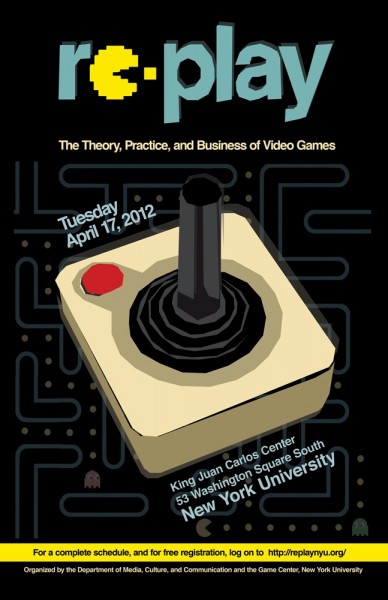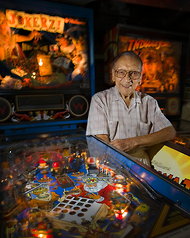
On April 17th, I am co-organizing the one-day Re:Play 2012 video game conference here at New York University.
Re:Play is sponsored by the Media, Culture & Communication Department at New York University’s Steinhardt School for Culture, Education and Human Development in collaboration with the New York University Game Center
The conference is free, but registration is required at the http://replaynyu.org/ site. Hope to see you there!
Program
9:00 – 9:45: Arrival and registration, coffee and pastries
9:45 – 10:00: Opening remarks
Panel 1
10:00 – 11:00: Video Games and Religion
Ask your average member of the clergy, and they’re likely to see video games as a waste of time at best or, at worst, as a nefarious destroyer of young souls. But games and religion, closed systems based on stringent rules and dedicated largely to ritual, have more in common than they might imagine. This panel will discuss the relationship between these two popular forms of personal reflection and communal interaction, seeing what, if anything, they might have to teach each other.
Moderator: Liel Leibovitz (NYU)
Panelists: Ryan Hennesy (Princeton), others TBA
11:00 – 11:15: Break
11:15 – 12:00: Interlude I: Music for EnvironManta: Painting a Universe with Melody
Katie Jacoby (NYU)
12:00 – 1:00: Lunch
Panel 2
1:00 – 2:00: Publisher Revolutions: Free-to-Play Economics
The gaming industry has proven resilient to economic turmoil and declining publisher revenues, growing at an annual rate of ten percent at a time when the U.S. economy grew only two percent per year and adding almost $5 billion to America’s GDP. This growth, however, belies the fundamental shifts currently taking place among the traditional value chain. Developers, publishers, and retailers all find themselves confronted with a changing market forcing each of them to assume a different role. This panel will discuss major trends such as the move toward free-to-play and the emergence of social gaming, and ask whether its emerging publishing models present a blue print for other entertainment industries.
Moderator: Joost van Dreunen (NYU Game Center)
Panelists: Stephen Ju (Credit Suisse), Janelle Benjamin (SuperData Research), Katharine Lewis (Fremantle
Media), Jessica Rosenblatt (Arkadium), Rainer Markussen (Gamigo), Gui Karyo (Atari)
2:00 – 2:15: Break
Panel 2a
2:15 – 3:00: Gamification Mini-Panel
In an attempt to connect theory with practice, this 30-minute panel will discuss the topic of gamification by examining and playing with its machinations.
Panelists: Paige MacGregor (NYU), Michelle Forelle (NYU), Max Foxman (NYU), Stephanie Llamas (NYU)
3:15 – 4:00: Interlude II: Video game presentation
A representative from one of the industry’s leading studios will showcase a popular, upcoming release.
Panel 3
4:00 – 5:00: Brand new, you’re Retro: Platforms and distribution models from the Atari 2600 to Angry Birds
With interactive entertainment entering into the mainstream, the demands made on designers and publishers have changed as well. No longer exclusively focused on the legendary “hardcore” gamer, we see game designs and business models changing.
But is all of this really new? In this panel, Nick Montfort and Jesper Juul will discuss how casual games fit in the history of video game. Are casual games new, or are they a return to the simplicity of early platforms like the Atari 2600 and once-mighty commercial genres like text adventures?
Panelists: Nick Montfort (CMS, MIT) and Jesper Juul (NYU Game Center)
5:00 – 5:15: Closing remarks
5:15 – 6:00: Cocktail reception




![faculty_panel6-450x600[1]](http://www.jesperjuul.net/ludologist/wp-content/uploads/2012/02/faculty_panel6-450x6001.jpg)